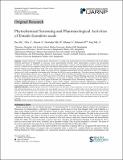| dc.description.abstract | Entada scandens (E. scandens) (family. Mimosaceae) is a widely used medicinal plant has been traditionally used by the folklore medicinal practitioners of Bangladesh to treat pain, cancer, gastrointestinal disorders where antinociceptive, cytotoxic and anti-diarrheal medications are implicated. Therefore, phytochemical groups and antinociceptive, cytotoxic, and anti-diarrheal activities of ethanol extract of seed of E.scandens were investigated by using acetic acid induced writhing model in mice, brine shrimp lethality bioassay and castor oil induced diarrheal model in mice. Phytochemical study of the extract indicated the presence of alkaloids, glycosides, tannins, flavonoids and saponins. At the doses of 250 and 500 mg/kg body weight, the extract showed a significant antinociceptive activity showing 60.61 and 72.73% inhibition
respectively (P<0.001) comparable to that produced by Diclofenac Na (80.30%) used as standard drug. The extract showed significant toxicity in the brine shrimp lethality bioassay (LC50. 20μg/ml & LC90. 80μg/ml). While evaluating anti-diarrheal activity, the extract inhibited the mean number of defecation which were 13.21% (P<0.01) and 22.64 % (P<0.001) at the doses of 250 and 500mg/kg respectively. The latent period for
the extract treated group was (p<0.01) increased as compared to control group. In addition, antimicrobial study was carried out by disc diffusion assay, but no significant inhibition was found against Escherichia coli, Pseudomonas aureus, Plesiomonas shigelloides, Salmonella typhi, S. paratyphi, Shigella dysenteriae, S. flexneri, S. boydii, S. sonnei, Proteus vulgaris, Enterococcus faecalis, Staphylococcus saprophyticus, S.
aureus, S. epidermidis and Streptococcus pyogenes. The study tends to suggest the antinociceptive, cytotoxic and antidiarrheal activities of the crude ethanol extract of the seed of E. scandens and justify its use in folkloric remedies. | en_US |

